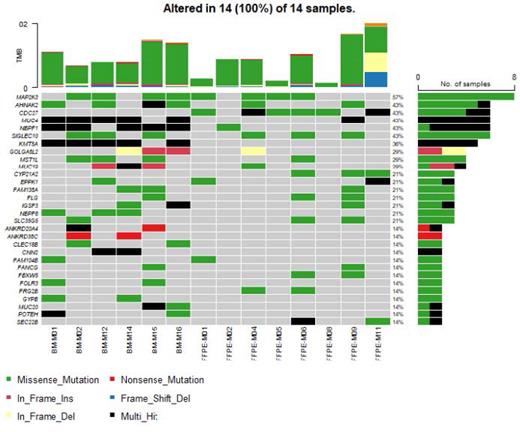Background
Extramedullary disease (EM) is aggressive form of MM in which clonal plasma cells exist outside the BM. EM may be found in up to 30% of MM patients and is associated with an adverse prognosis. However, the genetic pathogenesis of EM have not yet been precisely elucidated.
Patients and Methods
From 2005 to 2020, among patients diagnosed with MM with EM (EMM) confirmed by image study, a total of 12 patients for whom tumor tissue or BM specimens could be obtained were enrolled. Both bone-related EM (EM-B) and soft-tissue-related EM (EM-S) were defined as EM.
We performed whole-exome sequencing (WES) and NanoString nCounter assay to investigate the genetic alterations in EMM patients. A total of 9 formalin-fixed paraffin-embeded (FFPE) tumor tissues and 6 BM specimen from 12 EMM patients were sequenced. Paired BM and FFPE were available for analysis in 3 patients. To clarify the genetic difference between MM and EMM, 8 BM samples of 5 MM patients were analyzed as controls. In addition, 4 buccal swabs from one EMM patient were sequenced for germline control.
Results
The median age was 57 years (range 50-65). Two patients had EM-S involving meninges and Lt. psoas muscle showed adverse prognosis compared to patients with EM-B, with survivals of 1 month and 11 months after diagnosis of EM. One of them had a gain (1q21) chromosomal aberration classified as high risk cytogenetics.
WES was performed on 12 EMM cases (BM=6, FFPE=8). In WES, MAP2K3, AHNAK2, CDC27, MUC4, and NBPF1 were the five genes with the most variation in both BM and FFPE (Fig. 1). In particular, CDC27 gene was altered only in FFPE (6 out of 8 samples).
We performed RNA analysis by NanoString in 9 EMM patients (BM=6, FFPE=6) and 5 MM patients. Compared with MM, ARG1, IRF4, and CEP55 were up-regulated and CDKN1C, IL15, and CD3E were down-regulated in the BM of EMM. Comparison of BM specimens from MM and plasmacytoma from EMM showed IRF4 up-regulation in EMM. In plasmacytoma, chemokine and chemokine receptor related genes such as CXCL8, S100A9, S100A8, CCR4, CXCR2, and CXCR4 were down-regulated. Up-regulation of IRF4 was also observed in EMM when comparing normal buccal swab and EMM specimens.
Conclusions
In our study, significant genetic alterations have been identified. Especially, in WES analysis, CDC27 was mutated only in FFPE of EMM patients, and in Nanostring analysis, IRF4 was up-regulated all EMM samples. Further studies are needed to confirm the genetic alterations in more EMM patients.
Disclosures
Song:Novartis: Honoraria; Gilead: Honoraria; Amgen: Honoraria; Sanofi: Honoraria; Janssen: Honoraria; GSK: Honoraria; Forus: Honoraria; BMS: Honoraria.


This feature is available to Subscribers Only
Sign In or Create an Account Close Modal